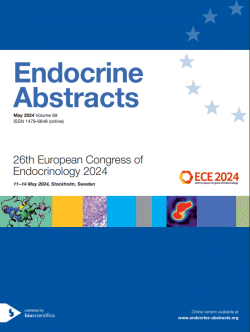
26th European Congress of Endocrinology
Stockholm,
Sweden
11 May 2024 - 14 May 2024

Rapid Communications
Rapid Communications 9: Pituitary and Neuroendocrinology | Part II
ea0099rc9.1 | Rapid Communications 9: Pituitary and Neuroendocrinology | Part II | ECE2024
Assessment of cardiovascular risk and coronary calcium deposits in women with hypopituitarism
Salhi Salma , Oueslati Ibtissem , Boukriba Seif , Talbi Emna , Yazidi Meriem , Feki Moncef , Mizouni Habiba , Chihaoui Melika
ea0099rc9.2 | Rapid Communications 9: Pituitary and Neuroendocrinology | Part II | ECE2024
Elevated prolactin: Do not over investigate, cannulate!
Hawkins Anna , Enriquez Nancy , Tanday Raj , Shah Usman , Chan Carmela , Casey Edel , Nikookam Khash
ea0099rc9.3 | Rapid Communications 9: Pituitary and Neuroendocrinology | Part II | ECE2024
Identifying potential small molecule “metabolites” as biomarkers for growth hormone deficiency (GHD): Insights from a novel mouse model
Al-Samerria Sarmed , Xu Huiting , Phelan Joseph , Diaz Rubio Maria Elena , Yamada Sayaka , Negron Ariel , Wondisford Fredric , Radovick Sally
ea0099rc9.4 | Rapid Communications 9: Pituitary and Neuroendocrinology | Part II | ECE2024
The novel SST3 agonist ITF2984 exerts antimitotic and proapoptotic effects in human non-functioning pituitary neuroendocrine tumor (NF-PitNET) cells
Di Muro Genesio , Catalano Rosa , Treppiedi Donatella , Maria Barbieri Anna , Mangili Federica , Marra Giusy , Di Bari Sonia , Esposito Emanuela , Nozza Emma , Lania Andrea , Locatelli Marco , Modena Daniela , Steinkuhler Christian , Peverelli Erika , Mantovani Giovanna
ea0099rc9.5 | Rapid Communications 9: Pituitary and Neuroendocrinology | Part II | ECE2024
Pregnancy and acromegaly: Clinical outcomes of retrospectively analysed data from the German Acromegaly Registry
Tonjes Anke , Wurfel Marleen , Quinkler Marcus , Knappe Ulrich , Honegger Jurgen , Krause.Joppig Nina , Bacher Konrad , Schopohl Jochen , Stormann Sylvere , Meyhofer Sebastian
ea0099rc9.6 | Rapid Communications 9: Pituitary and Neuroendocrinology | Part II | ECE2024
Prevalence and determinants of microvascular and macrovascular complications of diabetes in acromegaly patients: A prospective case-control cross-sectional study
Pirchio Rosa , Auriemma Renata Simona , Scairati Roberta , Tropiano Antonella , De Simone Ivan , Vergura Alice , Del Vecchio Guendalina , Pivonello Claudia , Pivonello Rosario , Colao Annamaria
ea0099rc9.7 | Rapid Communications 9: Pituitary and Neuroendocrinology | Part II | ECE2024
Pituitary apoplexy: A retrospective canadian single center cohort study
Parker Ellen , Ali Imran S. , Hebb Andrea , Kureshi Nelofar , Clarke David



